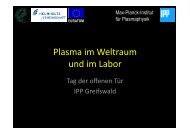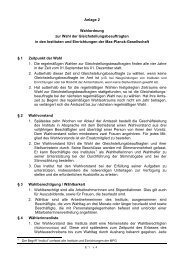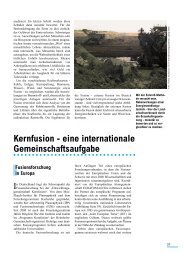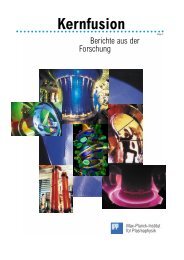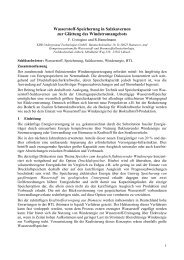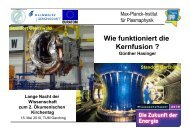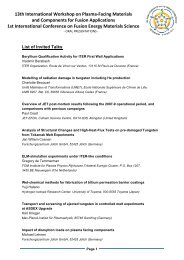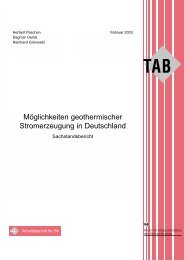IPP Annual Report 2007 - Max-Planck-Institut für Plasmaphysik ...
IPP Annual Report 2007 - Max-Planck-Institut für Plasmaphysik ...
IPP Annual Report 2007 - Max-Planck-Institut für Plasmaphysik ...
You also want an ePaper? Increase the reach of your titles
YUMPU automatically turns print PDFs into web optimized ePapers that Google loves.
the reference profile database. The neoclassical transport<br />
simulations for W7-X are based on the DKES database of<br />
mono-energetic transport coefficients for the low-mirror, the<br />
standard, and the high-mirror configurations with ι(a)=1.<br />
Here, the standard configuration has the lowest neoclassical<br />
transport which is further reduced with increasing β (whereas<br />
the bootstrap current increases with β). The high-mirror<br />
configuration fulfils the optimisation criterion of minimized<br />
bootstrap current as long as “electron-root” scenarios are<br />
avoided, although the bootstrap current is also expected to<br />
increase with β (due to reduction of the toroidal mirror term).<br />
The ray-tracing code TRAVIS has been included as a module<br />
in the transport code to self-consistently simulate modifications<br />
of electron cyclotron resonance heating (ECRH), noninductive<br />
current drive, and plasma profiles. The upgraded<br />
codes can now handle multi-beam heating schemes with reflection<br />
from mirrors and the vacuum vessel which is especially<br />
important for O2 (second harmonic of the ordinary mode)<br />
and X3 (third harmonic of the extraordinary mode) scenarios<br />
with incomplete first-pass absorption of the ECRH power.<br />
Transport Simulations of High-Power O2 Heating in W7-X<br />
ECRH at densities as high as 2×10 20 m -3 is envisaged for<br />
W7-X at the second harmonic of the ordinary mode (O2).<br />
First-pass absorption of O2 ECRH is relatively poor for the<br />
projected plasma parameters, enforcing the adoption of a<br />
multi-pass absorption scheme with a fixed launching geometry<br />
to conform with the placement of mirrors and reflecting<br />
surfaces within the vacuum vessel. Using the transport/raytracing<br />
package, this scheme is predicted to deliver threepass<br />
absorption in excess of 95 % and produce plasmas with<br />
〈β〉≈4 % for 10 MW of ECRH power. For such simulations,<br />
the combination of Shafranov shift and diamagnetic effect<br />
moves the ECRH deposition zone significantly inwards<br />
which is most easily counteracted by increasing the initial<br />
strength of B by several percent.<br />
ITER Benchmark of the Ray-Tracing Code TRAVIS<br />
A successful benchmark with the reference scenario 2 for<br />
ITER has been performed with the recently developed raytracing<br />
code TRAVIS. In particular, the electron cyclotron current<br />
drive (ECCD) was calculated for both the upper and equatorial<br />
launcher. It has been found that for the range of angles<br />
expected to be optimal for ECCD, accounting for momentum<br />
conservation is mandatory. Additionally, the scenario with<br />
reduced magnetic field has been considered, where it was<br />
found that the ECCD efficiency (as well as the deposition profile)<br />
may be significantly altered for the equatorial launcher<br />
due to unwanted absorption at the higher (parasitic) harmonics.<br />
Divertor Transport Studies for Helical Devices<br />
Transport essentials of the helical divertor in LHD were<br />
investigated and compared to those already intensively studied<br />
Theoretical Plasma Physics<br />
88<br />
for the island divertor of W7-AS, aiming at identifying common<br />
physics issues of two helical devices with completely<br />
different divertor concepts and geometries. For W7-X, a<br />
systematic numerical study of the island screening effect on<br />
recycling neutrals and intrinsic impurities has been started<br />
with the standard island divertor configuration; preliminary<br />
results are being analyzed. The EMC3-EIRENE code is<br />
being implemented for NCSX.<br />
Configuration Studies for W7-X<br />
The configuration space of Wendelstein 7-X has been explored<br />
at large toroidal mirror ratios. These configurations<br />
show worsened interchange stability properties as both<br />
shear and depth of the vacuum magnetic well are reduced so<br />
that most configurations become interchange unstable at<br />
medium to high β values. Another interesting quality is a<br />
further reduction of the parallel current density which completely<br />
suppresses the dipole component of the Pfirsch-<br />
Schlüter currents for mirror fields around 30 %. Configurations<br />
with negligible Shafranov shift at 〈β〉≈10 % can<br />
be found.<br />
Recovery of External Coil Currents for W7-X Vacuum<br />
Configurations<br />
The fast equilibrium reconstruction technique, called function<br />
parametrisation (FP), was applied, indirectly, to recover<br />
the external coil currents of W7-X in an inverse transformation.<br />
The “inversion” is in the mapping of (known or<br />
pre-determined) physical parameters of a configuration<br />
onto the coil currents. The importance of this lies in the<br />
fact that it serves to answer queries on the feasibility of<br />
desired configurations with respect to allowed values of<br />
external currents, something very crucial during the operation<br />
of stellarators. The method employs an iterative minimisation<br />
of target functions using the FP with the coil currents<br />
as independent parameters since direct inversion is<br />
not possible.<br />
Scientific Staff<br />
C. D. Beidler, M. Borchardt, S. Braun, M. Drevlak, D. Eremin,<br />
Y. Feng, J. Geiger; P. Helander, K. Kauffmann, R. Kleiber,<br />
A. Könies, H. Maaßberg, N. Marushchenko, A. Mishchenko,<br />
C. Nührenberg, J. Nührenberg, J. Riemann, A. Runov, F. Sardei,<br />
A. Sengupta, Yu. Turkin, P. Xanthopoulos, X. Zha.<br />
Guests<br />
J. Canic (ORNL), T. Fülöp (TU Chalmers Göteborg),<br />
L. Guazzotto (MIT), M. Kobayashi (NIFS), L. Koziol (USC),<br />
R. Maingi (ORNL), M. Mikhailov (Kurchatov <strong>Institut</strong>e),<br />
D. Mikkelsen (PPPL), A. Simakov (LANL), Z. Unterberg<br />
(DIII-D).




